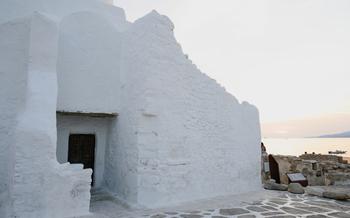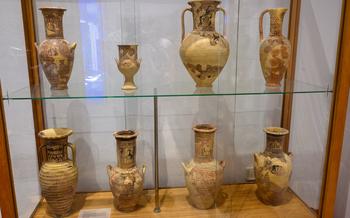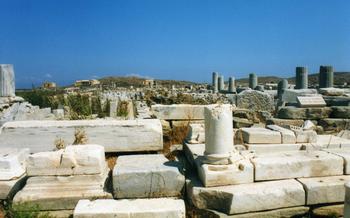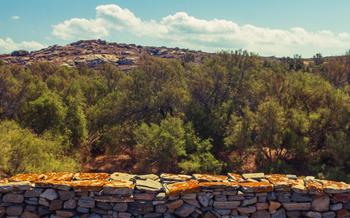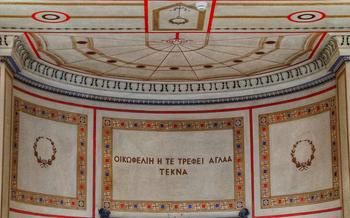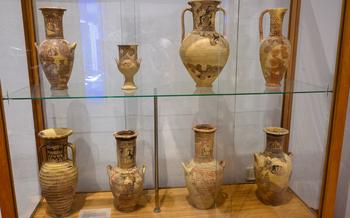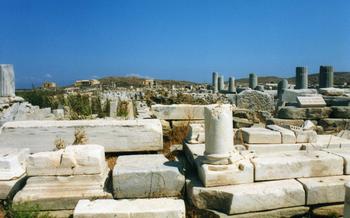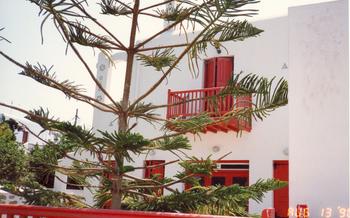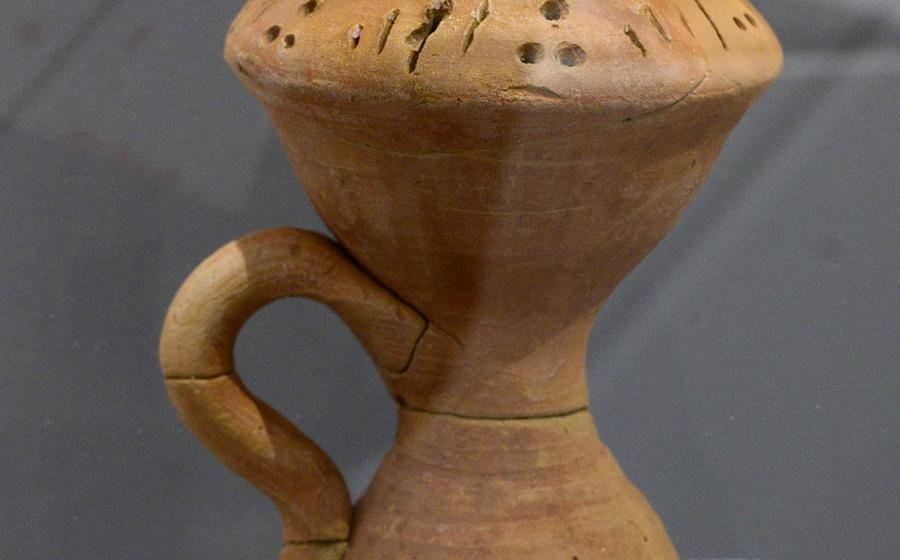
Archaeological Museum of Mykonos
- Historical Background
- Museum Location
- Museum Hours and Admission
- Exhibitions and Displays
- Cycladic Art
- Ancient Jewelry
- Pottery and Ceramics
- Marble Sculptures: Masterpieces in Stone
- Bronze Artifacts
- Interactive Exhibits
- Multimedia Presentations
- Temporary Exhibitions
- Museum Shop
- Guided Tours
- Insider Tip: Unveiling the Secrets of the Archaeological Museum
Historical Background
In the heart of the cosmopolitan island of Mykonos, a rich tapestry of history awaits discovery at the Archaeological Museum of Mykonos. This cultural treasure trove offers a profound journey through the island's storied past and the broader history of ancient Greece. As you wander through its halls, you will encounter an array of fascinating artifacts that eloquently narrate the evolution of Mykonian and Hellenic civilization.
Mykonos, with its idyllic shores and strategic location in the Aegean Sea, has been a significant crossroads for seafarers, merchants, and cultural influences throughout history. The island's strategic position made it a crucial node in ancient trade routes, fostering interactions with diverse civilizations across the Mediterranean. The Archaeological Museum of Mykonos stands as a testament to this vibrant history, showcasing the island's unique cultural heritage and its profound connections to the wider world of ancient Greece.
Museum Location
The Archaeological Museum of Mykonos is conveniently located in the heart of Mykonos Town, just a short walk from the picturesque waterfront and the iconic windmills. Its exact address is Kastro, Mykonos 846 00, Greece. To reach the museum, you can easily navigate the charming cobblestone streets, following signs or asking locals for directions.
For visitors with disabilities or special needs, the museum offers wheelchair accessibility and designated parking spaces nearby. The museum staff is always ready to assist with any specific requirements or provide additional information to ensure a comfortable and enjoyable visit for all.
Museum Hours and Admission
The Archaeological Museum of Mykonos is open to the public from 8:30 AM to 3:00 PM, seven days a week, except for national holidays. Visitors should note that during the peak tourist season, from July to September, the museum may have extended hours or special events. It is advisable to check the museum's website or contact them directly for the most up-to-date information on operating hours.
Admission to the museum is free of charge, making it an accessible and affordable cultural destination for visitors of all budgets. This free admission policy ensures that everyone has the opportunity to explore the rich history and heritage of Mykonos through the museum's remarkable collection.
Exhibitions and Displays
The Archaeological Museum of Mykonos houses a captivating collection of artifacts that narrate the rich history and culture of the island and the surrounding Cycladic region. The permanent exhibition showcases a diverse range of objects, including Cycladic sculptures, ancient jewelry, pottery and ceramics, marble sculptures, and bronze artifacts. Each artifact tells a unique story, providing a glimpse into the lives, beliefs, and artistic traditions of the ancient Greeks.
Among the highlights of the museum's collection are the exquisite Cycladic sculptures, dating back to the 3rd millennium BC. These enigmatic figurines, with their simplified forms and smooth, rounded surfaces, offer a glimpse into the earliest artistic expressions of the Cycladic civilization. The museum also boasts a remarkable collection of ancient jewelry, featuring delicate gold and silver pieces adorned with intricate designs and precious gemstones. These ornaments, once worn by the wealthy and powerful, showcase the exceptional craftsmanship and artistry of ancient Greek jewelers.
Cycladic Art
The Archaeological Museum of Mykonos houses a rich collection of Cycladic art, providing a glimpse into the unique artistic traditions of the Cycladic civilization, which flourished in the Aegean Sea from the 3rd millennium to the 1st millennium BC. Cycladic art is characterized by its distinctive simplicity, geometric forms, and emphasis on the human figure, particularly female figurines.
The museum showcases a variety of Cycladic sculptures, including the iconic marble figurines known as "Cycladic idols." These minimalist figures, often depicted with folded arms and a schematized face, embody the essence of Cycladic art. The museum also displays pottery and other artifacts from the Cycladic period, offering insights into the daily lives and cultural practices of this ancient civilization.
Among the highlights of the Cycladic collection is a marble figurine of a seated woman, dating from the 3rd millennium BC. The figure is remarkable for its elegant posture and the delicate carving of its facial features, capturing the essence of Cycladic minimalism. Another notable piece is a ceramic vase decorated with intricate geometric patterns, demonstrating the skilled craftsmanship of Cycladic potters.
Through the exploration of Cycladic art at the Archaeological Museum of Mykonos, visitors gain a deeper understanding of the rich cultural heritage of the Aegean region and the enduring legacy of this ancient civilization.
Ancient Jewelry
In the realm of ancient Greek adornments, the Archaeological Museum of Mykonos unveils a treasure trove of exquisite jewelry pieces that captivate visitors with their intricate designs and profound symbolism. These adornments, crafted with meticulous precision and artistic flair, reflect the exceptional craftsmanship and aesthetic sensibilities of ancient Greek artisans.
Gold, silver, and bronze were the primary materials used to create these ornaments, and intricate filigree work, granulation, and stone inlay techniques were employed to embellish them. The jewelry collection showcases a wide range of accessories, including necklaces, earrings, bracelets, rings, and headdresses, each adorned with a variety of motifs and symbols.
Geometric patterns, floral motifs, and depictions of mythological figures or animals were commonly used to decorate the jewelry. These motifs often held symbolic meanings, representing power, protection, love, or prosperity. For example, the owl, a symbol of wisdom and knowledge, was a popular motif in ancient Greek jewelry.
The jewelry collection also includes a number of amulets and talismans, believed to possess protective or magical powers. These amulets often depicted gods or goddesses, such as Zeus or Aphrodite, or symbols associated with them.
The ancient Greeks believed that jewelry was not merely a form of adornment, but also a means of expressing individuality, status, and personal beliefs. The Archaeological Museum of Mykonos offers a glimpse into this fascinating world of ancient Greek jewelry, allowing visitors to appreciate the artistry, symbolism, and cultural significance of these exquisite creations.
Pottery and Ceramics
The Archaeological Museum of Mykonos houses a captivating collection of pottery and ceramics, offering a glimpse into the remarkable craftsmanship and artistic traditions of ancient Greece. These artifacts, crafted from clay and fired in kilns, showcase the diversity and ingenuity of ancient Greek potters.
Among the highlights of the pottery collection are stunning examples of Cycladic pottery, characterized by their distinctive geometric patterns and intricate designs. These vessels, often used for everyday purposes such as storage or cooking, reveal the unique aesthetic sensibilities of the Cycladic civilization.
In contrast, the museum also features exquisite examples of Athenian pottery, known for its fine craftsmanship and intricate figural decoration. These vessels, often used for symposia (social gatherings) or as funerary objects, depict scenes from mythology, daily life, and religious rituals, providing valuable insights into ancient Greek culture and beliefs.
The museum's collection also includes a variety of ceramic figurines, ranging from small votive offerings to larger decorative pieces. These figurines, often depicting deities, heroes, or animals, offer a glimpse into the religious beliefs and artistic conventions of the ancient Greeks.
Through these exceptional pottery and ceramic artifacts, the Archaeological Museum of Mykonos invites visitors to discover the rich artistic heritage and cultural significance of ancient Greece, providing a tangible connection to the past.
Marble Sculptures: Masterpieces in Stone
The Archaeological Museum of Mykonos boasts an impressive collection of marble sculptures, each a testament to the skill and artistry of ancient Greek sculptors. These works of art span various periods, from the Archaic to the Hellenistic era, and showcase the evolution of sculptural styles and techniques.
Among the highlights is a graceful statue of a kouros, dating back to the 6th century BC. With its rigid stance and serene expression, this sculpture embodies the early stages of Greek sculpture, characterized by simplicity and symmetry. In contrast, a later kore statue from the 5th century BC exudes a sense of movement and fluidity, with its intricate drapery and expressive features.
The museum also houses a collection of marble reliefs, which depict scenes from mythology, daily life, and religious rituals. These reliefs offer a glimpse into the beliefs and customs of ancient Greece and provide valuable insights into the social and cultural context of the period.
One of the most striking reliefs is a depiction of the Battle of Marathon, where hoplites clash in a fierce struggle against the Persian army. The intricate details and dynamic composition of the relief bring the battle to life, capturing the intensity and drama of the conflict.
These marble sculptures not only showcase the technical prowess of ancient Greek artists but also offer a profound connection to the past, allowing visitors to appreciate the beauty and significance of these timeless masterpieces.
Bronze Artifacts
In addition to the impressive collection of marble sculptures, the Archaeological Museum of Mykonos also houses a noteworthy display of bronze artifacts, offering a glimpse into the exceptional craftsmanship and technological advancements of ancient Greece. These artifacts, ranging from tools and weapons to intricate sculptures, showcase the mastery of bronzeworking techniques that flourished during this era.
The museum's collection of bronze tools provides insights into the daily lives and industries of ancient Mykonos. Visitors can marvel at well-preserved agricultural implements, such as sickles and hoes, as well as tools used in various crafts, including chisels, hammers, and saws. These objects not only demonstrate the ingenuity and practicality of ancient toolmakers but also shed light on the diverse economic activities that sustained the island's population.
The collection also features an array of bronze weapons, highlighting the military prowess and defensive capabilities of ancient Mycenaean and Classical Greek societies. Swords, spears, and helmets, meticulously crafted with sharp blades and intricate designs, stand as testaments to the skill and artistry of ancient Greek metalworkers. These artifacts provide a tangible connection to the conflicts and battles that shaped the history of the region.
Beyond tools and weapons, the museum showcases a collection of bronze sculptures that exemplify the artistic achievements of ancient Greece. These sculptures, often depicting mythological figures or scenes from everyday life, demonstrate the versatility and expressive potential of bronze as a medium. From small statuettes to larger-than-life figures, these works of art embody the creativity and technical skill of ancient Greek sculptors.
The bronze artifacts at the Archaeological Museum of Mykonos offer a fascinating glimpse into the technological advancements and artistic prowess of ancient Greek civilization. By exploring these remarkable objects, visitors gain a deeper understanding of the ingenuity, craftsmanship, and cultural significance that characterized this influential period in history.
Interactive Exhibits
The Archaeological Museum of Mykonos offers a range of interactive exhibits designed to engage visitors, particularly younger audiences. These exhibits provide hands-on experiences that enhance the understanding of ancient Greek culture and make the museum visit more enjoyable and memorable.
One popular interactive exhibit is a replica of an ancient Greek pottery workshop. Visitors can try their hand at pottery making using traditional techniques and tools, creating their own unique pieces of pottery to take home as souvenirs.
Another interactive exhibit allows visitors to explore the process of creating ancient Greek sculptures. Using digital tools, visitors can manipulate virtual sculptures, rotate them in 3D space, and view them from different angles. This hands-on experience provides a deeper understanding of the techniques and skills used by ancient Greek sculptors.
Interactive games and quizzes are also available, testing visitors' knowledge of ancient Greek history, mythology, and art. These games are not only educational but also provide a fun way to learn about the ancient world.
Multimedia Presentations
The Archaeological Museum of Mykonos enhances visitors' experience by incorporating engaging multimedia presentations. These audiovisual displays bring ancient artifacts to life, providing a deeper understanding of their historical context and cultural significance. Through interactive touchscreens and immersive projections, visitors can explore detailed images, read informative texts, and watch videos that shed light on the stories behind the artifacts. These multimedia presentations offer a dynamic and interactive way to connect with the past, making the museum's collection accessible and compelling to visitors of all ages.
Temporary Exhibitions
The Archaeological Museum of Mykonos occasionally hosts temporary exhibitions that explore specific themes or periods in ancient Greek history. These exhibitions often feature unique artifacts from other museums or private collections, making them a must-visit for anyone interested in deepening their knowledge of the ancient world. Past temporary exhibitions have focused on various topics, such as the history of Mykonos itself, the influence of ancient Greek art and culture on modern artists, and the role of women in ancient Greek society.
To stay updated on current and upcoming temporary exhibitions, visit the museum's website or social media pages. Booking tickets in advance is recommended, especially during peak tourist season, to avoid long queues and ensure your spot in the exhibition. Don't miss the chance to delve into the rich history and culture of ancient Greece through these immersive and informative temporary exhibitions.
Museum Shop
The Archaeological Museum of Mykonos houses a well-stocked museum shop where visitors can purchase a variety of souvenirs and educational materials to commemorate their visit. From postcards and magnets featuring iconic artifacts to replicas of ancient jewelry and pottery, the shop offers a wide range of items to suit every budget and taste.
For those seeking a unique memento of their time in Mykonos, the museum shop offers a selection of handmade crafts and locally produced items inspired by ancient Greek culture. These include hand-painted ceramics, woven textiles, and olive wood carvings, all crafted by skilled artisans using traditional techniques.
For those interested in delving deeper into the history and culture of ancient Greece, the museum shop also offers a selection of books, guides, and educational materials. These publications cover a wide range of topics, from the history of Mykonos and the Cyclades to the significance of the artifacts displayed in the museum.
Whether you're looking for a souvenir to remind you of your visit, a gift for a loved one, or simply a way to learn more about ancient Greek culture, the Archaeological Museum of Mykonos' museum shop is sure to have something for you.
Guided Tours
If you want to delve deeper into the captivating history and significance of the artifacts, guided tours are available in various languages, offering an immersive and educational experience. Knowledgeable guides will lead you through the museum's galleries, providing expert insights and anecdotes that bring the ancient world to life.
Booking a guided tour in advance is highly recommended, especially during peak tourist season, to secure your spot and avoid disappointment. Tours typically cover the highlights of the museum's collection, providing a comprehensive overview of ancient Greek culture and artistry.
Whether you're a history buff, an art enthusiast, or simply curious about the past, a guided tour at the Archaeological Museum of Mykonos will enhance your visit and leave you with a lasting appreciation for the treasures of antiquity.
Insider Tip: Unveiling the Secrets of the Archaeological Museum
As you explore the Archaeological Museum of Mykonos, keep an eye out for hidden gems that often go unnoticed by visitors. In a secluded corner of the museum, discover a remarkable collection of ancient coins, offering a glimpse into the economic and political systems of ancient Greece. These coins, adorned with intricate designs and symbols, provide a tangible connection to the past.
For a unique photographic opportunity, head to the museum's rooftop terrace. Overlooking the picturesque town of Mykonos and the shimmering Aegean Sea, this spot offers breathtaking views that will elevate your Instagram game. Capture the essence of ancient Greece against the backdrop of a modern-day paradise.
To make the most of your visit, consider joining a guided tour. Led by knowledgeable experts, these tours delve deeper into the stories behind the artifacts, providing insights into the lives and culture of the ancient Greeks. Take advantage of this opportunity to ask questions and gain a richer understanding of the museum's treasures.
Remember, the Archaeological Museum of Mykonos is more than just a collection of artifacts; it's a journey through time. Embrace the opportunity to connect with the past, uncover hidden secrets, and create lasting memories in this remarkable place.
